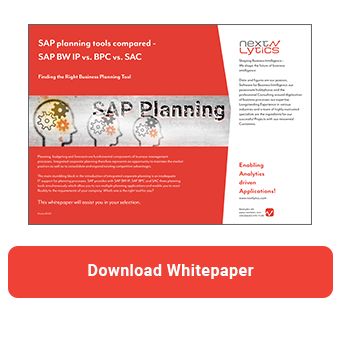Recent geopolitical events and aftermath of the Corona pandemic are testing businesses worldwide. Disrupted supply chains and rising energy prices demand continuous adaptation of plans. Support from the right IT tools also plays an important role. What are the most important trends at the moment? What is the current state of planning with SAP? Can SAP tools meet the growing demands? That's what we'll explore in this article.
Excel Legacy
Although constant changes call for more agility, many companies let outdated technology slow them down. For example, most companies still use Excel for their business planning, a tool from the 1980s. While Excel scores high in the area of flexibility, it is also particularly prone to errors. Furthermore, the poor integration of master and transaction data leads to low data quality. In addition, data visualization is inadequate for today's conditions.
For all Excel fans, SAP offers two alternatives: SAP Analysis for Office and SAP Analytics Cloud for Office. Analysis for Office (AfO) is geared toward planning with SAP Business Planning and Consolidation (SAP BPC), while SAP Analytics Cloud for Office supports planning with SAP Analytics Cloud (SAC). Both tools offer business users the possibility to work in a familiar Excel interface and to execute proven Excel functionalities ad-hoc. The main difference to pure Excel planning is that planning with SAP is based on consistent data that complies with the "one version of the truth" principle. In addition, predefined planning functions can be used to speed up the planning process. As a result, planning becomes faster and more flexible.

Long-term planning
Solid long-term planning conditions the success of every company. While ERP and SCM products such as SAP S/4HANA and SAP IBP are excellent for operational planning, tactical to strategic planning requires less detail and more flexibility. Here, SAP sends two products into the race at once: SAP Business Planning and Consolidation (SAP BPC) and SAP Analytics Cloud (SAC). Both are designed to meet customer-specific requirements with customized solutions. These tools work according to the modular principle and thus allow different planning areas to be mapped individually.
While SAP BPC is based on on-premise business warehouse systems, SAC is a pure cloud tool marketed as SaaS. SAP BPC is a proven tool with extensive customizing options, whose maintenance is supported by SAP until 2040. SAC is a relatively new tool that is cloud based and naturally allows less customizing. SAP is positioning SAC as the strategic planning solution of the future and is investing heavily in new features. Whereby the latest innovations also strengthen the integration of BPC and SAC. This makes SAC increasingly suitable as a modern front end for the proven BPC planning applications.
Data modeling
Unfortunately, in practice we repeatedly observe that a lot of time is spent on data preparation and orchestration of data between different systems. This time spent collecting, consolidating, and validating information is missed when analyzing data and then planning. SAP supports decision makers by automating ETL processes so that a harmonized data basis is available at the end. Of course, a monolithic SAP architecture has advantages in achieving "one version of the truth". SAP has also recently expanded its interfaces to other providers. For example, SAC and SAP Datasphere (formerly SAP Datawarehouse Cloud) also support the relatively problem-free connection of third-party tools. Less time for data modeling means more time for analysis and planning.
SAP Planning tools compared -
Dowload the Whitepaper here!
Live data
The introduction of HANA technology opens up another opportunity to improve the planning process. Users can thus access live data from the source systems in a performant manner. SAP Analytics Cloud (SAC), for example, can access and display posted values using live connections to S/4HANA ERP without having to wait for any nightly loading processes. With this opportunity planners have a constantly updated database that reflects the latest developments and enables better planning. For reports, the use of live data has long been adopted. However, data must still be loaded and persisted into SAC if it is to be used in planning functions. So if, for example, you want to copy the most current data as a starting point for planning in a new version, it must first be loaded into the SAC. Here, SAP would still have potential for improvement in the future.

Skills
Of course, the latest technologies are of no use if there is a lack of the corresponding know-how in the company. This applies both to developers who build the planning application and to planners who will ultimately operate the tool. To close this skills gap, SAP provides support in the form of so-called "Open SAP Courses", where free training is offered. In addition, the SAP Learning Hub exists as a paid platform. In addition, there are tons of courses, books and blogs where you can expand your knowledge.
Thus, in addition to investing in appropriate infrastructure and tools, it is also important to invest in your own employees. After all, a lack of employee qualifications and technological know-how are the main reasons for the failure of many ambitious planning projects.

What does the future hold?
What innovations can we expect in the future? Given current developments, we will certainly see more use of Artificial Intelligence (AI) in planning and reporting. In fact, SAP already has AI-enabled Natural Language Query (NLQ) for data analytics in the SAC pipeline. At Datasphere, automatic recognition of similar data sets is expected to facilitate data modeling.
In addition, we see increased integration of SAC with Microsoft Office. SAP recognizes that many users still value the flexibility of Excel. Especially for planning, this allows individual calculations to be performed quickly. The expansion of SAP Analytics Cloud Add-Ins is certainly heading in the right direction.
What we are particularly excited about is the use of SAP Datasphere (formerly SAP Datawarehouse Cloud) in planning. At the moment, Datasphere can only be used for reporting. Expanding Datasphere to a platform for planning would be the next logical step.
Do you have questions about this or other topics? Are you trying to build up the necessary know-how in your department or do you need support with a specific question? We are happy to help you. Request a non-binding consulting offer today.

/Logo%202023%20final%20dunkelgrau.png?width=221&height=97&name=Logo%202023%20final%20dunkelgrau.png)
























